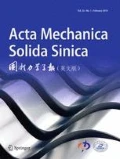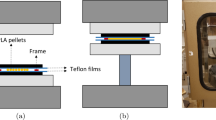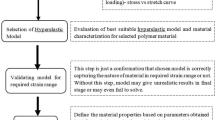Abstract
Polymer-bonded sugars (PBSs) can be used as a substitute material for polymer-bonded explosives (PBXs) due to their ability to simulate the mechanical properties of PBXs. In the process of pressing a PBS, the length of the dwell time has a significant impact on the mechanical properties of the PBS. This reinforcing effect is based on the residual pressure causing the binder to flow and gradually fill each defect. Through the use of Darcy’s principle of binder infiltration and viscoelastic theory, an exponential relationship between the compressive strength of PBS and the dwell time has been derived. From the experiments, it was found that the extreme forces that correspond to the compaction stage of the PBS samples with different dwell times were almost the same; this indicates that there is tolerance to damage during the compaction stage. The existence of the compaction stage is related to the brittleness of the PBS. The experimental results showed that as the dwell time increased, the rate of damage evolution of the specimen decreased.


















Similar content being viewed by others
References
Christensen RM. Residual-strength determination in polymetric materials. J Rheol. 1981;25:529–36.
Ho SY. Impact ignition mechanisms of rocket propellants. Combust Flame. 1992;91:131–42.
Seaman L, Curran DR. Murri WJ A continuum model for dynamic tensile microfracture and fragmentation. J Appl Mech. 1985;52:593–600.
Rae PJ, Goldrein HT, Palmer SJP, Field JE, Lewis AL. Quasi-static studies of the deformation and failure of \(\beta \)-HMX based polymer bonded explosives. P R Soc A-Math Phys. 2002;458:743–62.
Rae PJ, Palmer SJP, Goldrein HT, Field JE, Lewis AL. Quasi-static studies of the deformation and failure of PBX 9501. P R Soc A-Math Phys. 2002;458:2227–42.
Chen P, Huang F, Ding Y. Microstructure, deformation and failure of polymer bonded explosives. J Mater Sci. 2007;42:5272–80.
Chen P, Xie H, Huang F, Huang T, Ding Y. Deformation and failure of polymer bonded explosives under diametric compression test. Polym Test. 2006;25:333–41.
Li XD, Xie HM, Kang YL, Wu XP. A brief review and prospect of experimental solid mechanics in China. Acta Mech Solid Sin. 2010;23:498–548.
Palmer SJP, Field JE, Huntley JM. Deformation, Strengths and Strains to Failure of Polymer Bonded Explosives. P R Soc A-Math Phys. 1993;440:399–419.
Wang ZY, Ma L, Wu LZ, Yu HJ. Numerical Simulation of Crack Growth in Brittle Matrix of Particle Reinforced Composites Using the XFEM Technique. Acta Mech Solid Sin. 2012;25:9–21.
Xiao Y, Sun Y, Zhen Y, Guo L, Yao L. Characterization, modeling and simulation of the impact damage for. Int J Impact Eng. 2017;103:149–58.
Gray III GT, Idar D, Blumethal WR, Cady C. High-and low-strain rate compression properties of several energetic material composites as a function of strain rate and temperature In: Proceedings 11th international detonation symposium, Snowmass, CO 1998 76–84.
Wu YQ, Huang FL. A micromechanical model for predicting combined damage of particles and interface debonding in PBX explosives. Mech Mater. 2009;41:27–47.
Prakash N, Seidel GD. Computational electromechanical peridynamics modeling of strain and damage sensing in nanocomposite bonded explosive materials (NCBX). Eng Fract Mech. 2017;177:180–202.
Tan H, Huang Y, Liu C, Ravichandran G, Inglis HM, Geubelle PH. The uniaxial tension of particulate composite materials with nonlinear interface debonding. Int J Solids Struct. 2007;44:1809–22.
Chen JK, Huang ZP, Zhu J. Size effect of particles on the damage dissipation in nanocomposites. Compos Sci Technol. 2007;67:2990–6.
Chen JK, Huang ZP. Mai YW Constitutive relation of particulate-reinforced viscoelastic composite materials with debonded microvoids Acta. Mater. 2003;51:3375–84.
Zhang MH, Chen JK, Zhao F, Bai SL. A new model of interfacial adhesive strength of fiber-reinforced polymeric composites upon consideration of cohesive force. Int J Mech Sci. 2016;106:50–61.
Drodge DR, Williamson DM, Palmer SJP, Proud WG, Govier RK. The mechanical response of a A new model of interfacial adhesive strength of fiber-reinforced polymeric composites upon consideration of cohesive force. J Phys D: Appl Phys. 2010;43:335403.
Chen JK, Li JL, Zhu LM, Li KW, Zhao F, Bai SL. On the tension-induced microcracks’nucleation in a PBX substitute material under impact compression loading. Int J Mech Sci. 2017;134:263–72.
Seidel GD, Allen DH, Helms KLE, Groves SE. A model for predicting the evolution of damage in viscoelastic particle-reinforced composites. Mech Mater. 2005;37:163–78.
Yang K, Wu Y, Huang F, Li M. Numerical simulations of mechanical and ignition-deflagration responses for PBXs under low-to-medium-level velocity impact loading. J Hazard Mater. 2017;337:148–62.
Liu YR, Duan ZP, Zhang ZY, Ou ZC, Huang FL. A mesoscopic reaction rate model for shock initiation of multi-component PBX explosives. J Hazard Mater. 2016;317:4451.
Skidmore CB, Phillips DS, Howe PM, Mang JT, Romero JA. The evolution of microstructural changes in pressed HMX explosives. In: Proceedings 11th international detonation symposium, Snowmass, CO 1998;556–564.
Burnside NJ, Son SF, Asay BW, Skidmore CB. Particle characterization of pressed granular HMX. University of Massachusetts, Amherst. 1998. MA.
Housiadas KD. Internal viscoelastic flows for fluids with exponential type pressure-dependent viscosity and relaxation time. J Rheol. 2015;59:769–91.
Ravindran S, Tessema A, Kidane A. Multiscale damage evolution in polymer bonded sugar under dynamic loading. Mech Mater. 2017;114:97–106.
Hu Z, Luo H, Bardenhagen SG, Siviour CR, Armstrong RW, Lu H. Internal deformation measurement of polymer bonded Sugar in compression by digital volume correlation of in-situ Tomography. Exp Mech. 2015;55:289–300.
Chen L, Han D, Bai SL, Zhao F, Chen J. Compressive behavior and damage evaluation of a PBX substitute material. Mech Adv Mater Struct. 2017;24:737–44.
Chen L, Han D, Bai SL, Zhao F, Chen J. Study on the relation betweenmicrostructural change and compressive creep stress of a PBX substitute material. Sci Eng Compos Mater. 2018;25:731–7.
Chen F, Yu LC, Shen Q, Zhang LM. Fabrication of TZ-3Y20A/Mo multilayer composites by particle sedimentation method. J Mater Process Tech. 2008;199:37–40.
Çetin A, Kalkanli A. Effect of solidification rate on spatial distribution of SiC particles in A356 alloy composites. J Mater Process Tech. 2008;205:1–8.
Wu X, Xia K. Back pressure equal channel angular consolidation—Application in producing aluminium matrix composites with fine flyash particles J Mater Process Tech. 2007;192–193:355–359.
ElRakayby H, Kim K. Effect of stacking fault energy on densification behavior of metal powder during hot isostatic pressing. Mater Des. 2016;99:433–9.
Chen P, Qian LJ, Bai XX, Choi SB. Velocity-dependent characteristics of magnetorheological fluids in squeeze mode considering the hydrodynamic and the magnetic field interactions. J Rheol. 2017;61:455–65.
Koshiba T. Measurement of pressure loss in the flow of polymer solutions through packed beds of particles. Rheol Acta. 1994;38:438–45.
Christensen RM. Theory of viscoelasticity, an introduction. 2nd ed. Amsterdam: Elsevier; 1982. p. 1–34.
Acknowledgements
The authors would like to acknowledge the financial support by NSAF (U133010) and NSFC (11472141), and K. C. Wong Magna Fund in Ningbo University.
Author information
Authors and Affiliations
Corresponding author
Rights and permissions
About this article
Cite this article
Yang, Y., Lv, H. & Chen, J. The Exponential Law Between Dwell Time and the Strength of PBX Substitute Material. Acta Mech. Solida Sin. 34, 204–220 (2021). https://doi.org/10.1007/s10338-020-00184-x
Received:
Revised:
Accepted:
Published:
Issue Date:
DOI: https://doi.org/10.1007/s10338-020-00184-x




